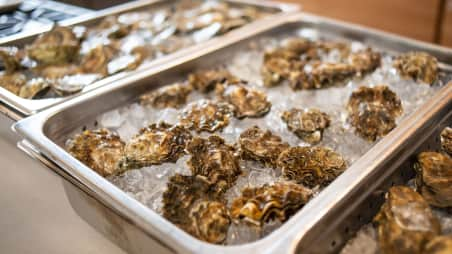Everyone remembers their first oyster. I had mine back in 2004, when I was working as a garde-manger at UpStairs on the Square, the iconic azalea-pink dining room that for decades graced the top three floors of a Harvard Square brownstone. When I admitted to my sous chef that I’d never tried a raw oyster, he plucked one from my station, shucked it, and offered it to me. I was unprepared to be transported to the cold, blue waters of Wellfleet, Massachusetts, as the liquor that I tipped from that gently gnarled gray-and-green shell flooded my palate with salt. But as I chewed, that brininess was tempered by the umami-rich, creamy flavors packed in the oyster’s plump body. It was, as oyster expert Rowan Jacobsen, author of the award-winning book A Geography of Oysters: The Connoisseur’s Guide to Oyster Eating in North America (2007), recently described to me, “a little bit of the sea come to life.”
I was immediately won over, and I have downed at least 1,000 oysters since then—not only in bars and restaurants but also at home with friends, which has become one of my favorite ways to entertain. Plattering up a dozen or two on the half shell is simpler than you might think and makes an impressive starting point for any gathering.

A Few Good Reasons to Try Oysters
They're stunningly diverseThere are five species of commercially cultivated oysters farmed in North American coastal waters: eastern, Pacific, European flat (also known as belon), Kumamoto, and Olympia. Like wine grapes, each oyster possesses certain inherent shape and flavor characteristics as well as innumerable delightful nuances determined by exactly where and how it’s been farmed. Even bivalves of the same species raised in neighboring bays can look and taste distinctly different.
They're environmentally friendlyEverything oysters need to grow occurs naturally in their habitat, which sets them apart from other seafood cultivated via aquaculture. Plus, oysters are filter feeders that strain out excess nitrogen and microparticles as they pump water through their bodies, purifying the habitat for marine life around them.

“More than any other food, oysters taste like the place they come from.”
—–Rowan Jacobsen, author and oyster expert
They're safe to eatNearly 98 percent of oysters we eat come from aquaculture, an industry that’s scrupulously regulated by federal and state agencies.
They can be great year-roundAll oysters are plump and flavorful from late fall through spring, but triploids—oysters developed by scientists to have three sets of chromosomes instead of two (diploids)—are just as good in summer months. They’re sterile and, thus, retain all their stored food instead of giving it up to spawn, which depletes their mass.

How to Shop

Illustration: John Burgoyne
In PersonSpecimens should be heavy for their size (a sign of freshness) and shut tight (or close up when you touch them).
OnlineOysters are increasingly available online directly from farmers, and they tolerate shipping exceptionally well because they can survive out of water for days as long as they’re kept fridge-cold.
Here are a few of our favorite purveyors and the oysters they offer. Bon Secour Fisheries (Eastern)Real Oyster Cult (Eastern, Pacific)Taylor Shellfish Farms (Pacific, Kumamoto)
How to Shuck
With an oyster knife, a dish towel, and some practice, you’ll be able to shuck safely and confidently.

1. Fold dish towel several times into thin, tight roll. Grip towel in fist of hand that will be holding oyster, wrapping 1 end over your thumb and tucking it between your thumb and forefinger.

2. Using your towel-protected thumb, hold oyster in place with hinge facing away from thumb. Insert tip of oyster knife into hinge of oyster.

3. Work tip of knife into hinge using twisting motion. When shells begin to separate, twist knife to pop hinge.

4. Run knife along top shell, scraping abductor muscle from shell to release oyster. Slide knife under oyster to scrape abductor muscle from bottom shell.
Sign up for the Cook's Insider newsletter
The latest recipes, tips, and tricks, plus behind-the-scenes stories from the Cook's Illustrated team.
How to Store
Depending on the variety and freshness, oysters keep anywhere from a few days to a week as long as they’re refrigerated. (Online sources often specify shelf life.) Keep them in a bowl covered with a damp towel, remoistening it as needed to prevent the oysters from drying out. Do not store oysters directly on or underneath ice; they will die in fresh water. (It’s OK to place them on ice for serving.)
How to Serve

Offer ice-cold raw oysters plain, with lemon wedges or hot sauce, or with accompaniments such as Red Wine Vinegar Mignonette Granité and Lime-and-Soy-Marinated Scallions. Serve them on a frosty bed of crushed ice. Five pounds will create a 1½-inch-thick layer of ice in a rimmed baking sheet—enough to keep twenty-four 2½- to 3-inch oysters cold for about 30 minutes. If you're using a smaller platter, store extra ice in a colander set in a bowl in the fridge. Use this stash to refresh your oyster platter as needed.

For the Best Crushed Ice, Grab a Skillet
In minutes, you'll have the perfect foundation for a frosty bed for raw oysters.
learn moreHow to Eat
SIP some of the liquor. It’s OK to pour off some and also OK if some spills during shucking.
SLURP the whole oyster into your mouth.
CHEW it well so that you really get to taste it.
Why Roasting is a Great Option
If you’re nervous about shucking or eating raw oysters or simply want a new way to serve them on the half shell, roasting is a great option. Warming them makes them much easier to shuck, and in our recipe, the mustard butter melds with the liquor to form a punchy sauce.


Oysters on the Half Shell
Oysters are diverse, sustainable, increasingly accessible, and festive—and preparing them in your own kitchen is eminently doable.
Get the Recipe
Roasted Oysters on the Half Shell with Mustard Butter
Oysters are diverse, sustainable, increasingly accessible, and festive—and preparing them in your own kitchen is eminently doable.
Get the Recipe